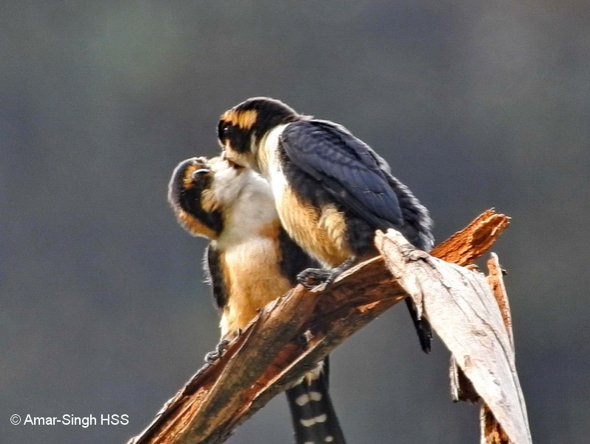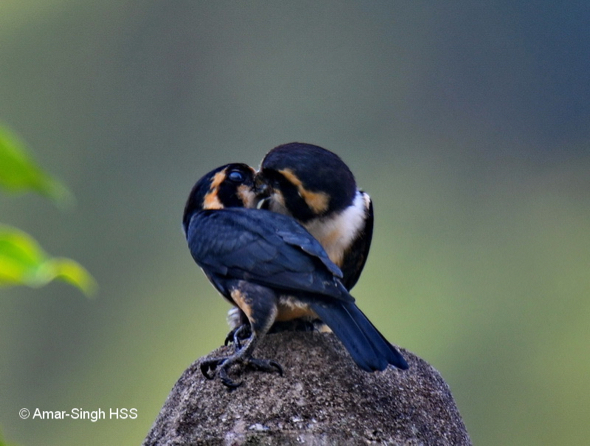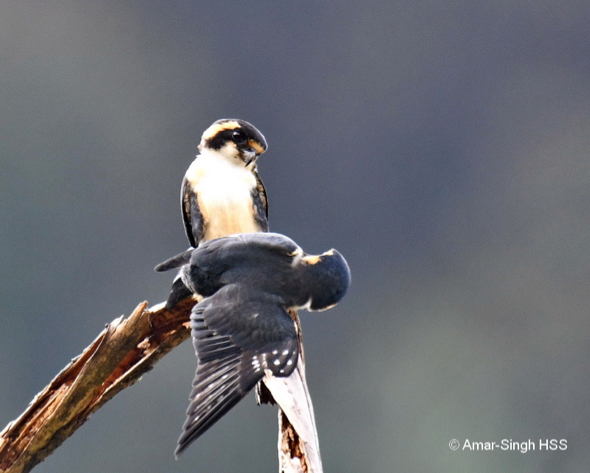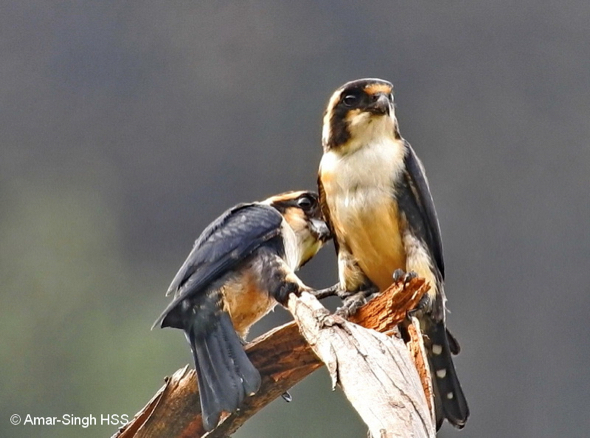“I posted juvenile Black-thighed Falconets (Microhierax fringillarius) that fledged in the middle of May 2019. They have been feeding independently for some time. I went back for a visit and observed two of them displaying courtship behaviour. These birds are first year Black-thighed Falconets (part of the brood that fledged recently) as seen from the significant residual rufous colouration on the white parts of the head (although some adult females may retain some rufous content into the second year – see Ferguson-Lees & Christie 2001 and HBW 2019). One bird had more rufous in the head and is possibly the female. Some notes on the courtship behaviour I observed:
1. Allopreening: This was very common and prolonged. This is a well-known courtship behaviour in this species (below).
2. Nibbling: I am not sure how to refer to this behaviour that was also frequent. One bird would ‘bite’ or rather ‘nibble’ the neck, legs, feet, etc of the other bird. A little different from allopreening where there is preening or grooming of the feathers of the partner.
3. Billing: I saw frequent ‘mouthing’, or rather I should call it ‘billing’. The birds would lock their beaks and nibble between beaks (below).
4. Submission Postures: One bird would assume a lower posture, either on a branch or even to the extent of lying down in front of the other bird. During this display, the other partner watches intently. The presumed female appeared to offer submission postures more often (below).
5. Holding/gripping Partners Leg: On three occasions I saw one bird forcefully grip the leg of the bird. Occasionally the other bird would respond by nibbling the claw griping the leg (below).
6. Flight Displays: the birds would also engage in joint flight/aerial displays where they would fly off together high up, falling back sharply to the perch or ground. On one occasion I saw them lock claws (grappling) while dropping in flight (akin to what we observe in larger raptors courtship displays).
7. Inspecting the Rear End: On a number of occasions I saw one bird inspect the rear end of the other bird, very much like dogs do. The presumed male appeared to do this action more often. At first I thought this was nibbling the rear of the leg, but saw it too often to be mistaken.
8. Although they had one preferred perching site, they did move from site to site while courting.
9. I did not hear any calls associated with the courtship.
10. I did not see any courtship feeding. I did see one episode where one bird attempted to share the dragonfly caught by the other bird but was refused.
11. There were no leaf gifts during the duration of my observation, as described in Pied Falconets (Allen et al 2002).
12. I did not observe any copulation.
“In view that they were first year birds and recently independent, I did consider if the behaviour I was observing was more of sibling affection rather than courtship. But the duration, wide range of behaviours shown and the extensive nature of the activities suggests that this is courtship or at least attempted/sham courtship.
“Merged videos of some courtship behaviour below.”
Dato’ Dr Amar-Singh HSS
Ipoh, Perak, Malaysia
1st July 2019
Location: Ipoh City, Perak, Malaysia
Habitat: Limestone hills at outskirts of the city
References:
1. James Ferguson-Lees, David A. Christie (2001). Raptors of the World. Bloomsbury Publishing PLC.
2. Clark, W.S. & Kirwan, G.M. (2019). Black-thighed Falconet (Microhierax fringillarius). In: del Hoyo, J., Elliott, A., Sargatal, J., Christie, D.A. & de Juana, E. (eds.). Handbook of the Birds of the World Alive. Lynx Edicions, Barcelona. (retrieved from HERE on 1 July 2019).
3. Desmond Allen, Paul I Holt, Jon Hornbuckle (2002). Leaf presenting As Possible Courtship Behaviour by Pied Falconets Microhierax Melanoleucos. The journal of the Bombay Natural History Society. Volume 99, pg 518—520.
4. Ong Kiem Sian (2006). Courtship of the Black-thighed Falconet. Bird Ecology Study Group LINK.
5. Connie Khoo (2007). Black-thighed Falconet: Mating and nesting rituals. Bird Ecology Study Group LINK.













